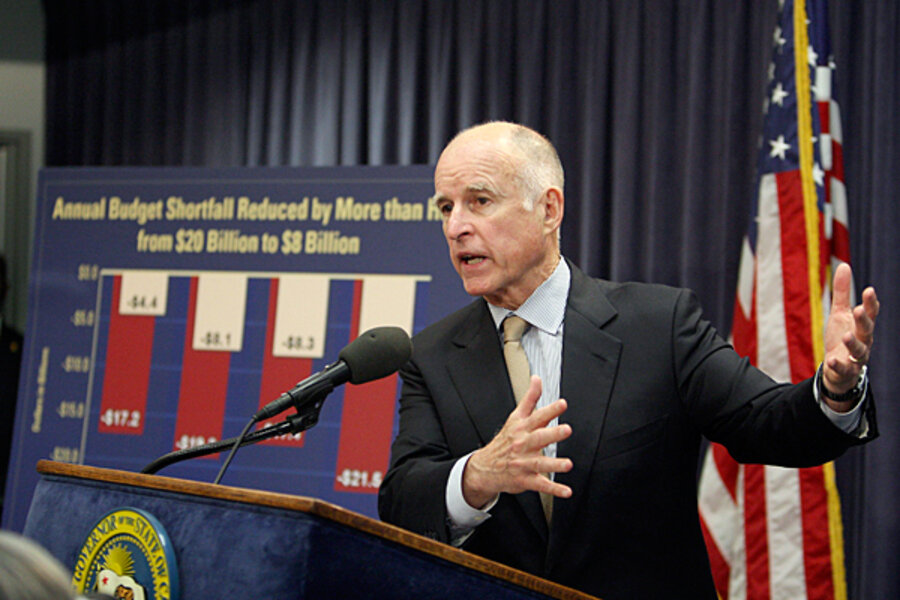Jerry Brown proposes billions in cuts. Are Californians getting his message?
Loading...
| Los Angeles
California Gov. Jerry Brown is facing the music.
Hit with a soaring state budget shortfall of $15.7 billion – up from $9.2 billion as recently as January – Governor Brown announced proposals Monday to make $8.3 billion in painful, cross-the-board cuts that quickly elicited outcries from those affected.
Most telling of his predicament, and his strategy, Brown admonished California voters that if they don’t pass his tax-hike initiative in November, $6 billion more will have to come out of budgets for public schools and higher education.
“We have so much money from the people, and we have so much spending,” the governor said at a press conference in Sacramento before jetting to Los Angeles to release further details. “We can be out of alignment for awhile, but now – given the decade of fiscal disconnect – I’ve committed to right the ship of state and getting it into balance.”
The proposals include cuts to state employees’ pay – and work week – as well as trims in spending on a wide variety of public programs and institutions: state prisons; care for the disabled; $500 millon from the state court system; and a one-year state building freeze.
“These budget cuts have something in them that will hit every Californian. The pain will be severe,” says Barbara O’Connor, director emeritus of the Institute for Study of Politics and Media at California State University, Sacramento.
“They are evenly spread,” she says, “and education at all levels – as well as health and human services and public safety – will be the focal points in this round of cuts.
“There have already been several previous rounds of cuts,” she adds. “These cuts will also endanger federal programs that California could qualify for.”
Political analysts say Brown is playing the problem as directly as can be expected, given the shortfall in expected tax revenues, higher costs to fund schools, and decisions by the federal government and courts to block budget cuts that had already been approved.
“Governor Brown is doing all he can to press for the tax increase solution by touting wide-reaching and unpleasant budget cuts as necessities without those tax increases,” says Steven Schier, a political scientist at Carleton College, in an e-mail.
Brown said he wants to cut Medi-Cal, California’s Medicaid program, by $1.2 billion and keep another $1.2 billion in cuts to welfare and child-care that he proposed in January.
Advocacy groups and health-care and welfare organizations are crying out.
“The governor has proposed that the legislature fund a $1 billion rainy day fund, but we think it's raining now, and some funds should be used to backfill welfare-to-work programs,” says Ron Coleman, statewide policy analyst for the California Immigrant Policy Center. “Doing this now is antithetical to the recovery that the state needs to get out of this fiscal mess. Historically, California has come back by putting people back to work.”
People are not taking the news of Brown’s proposals sitting down.
Rallies by several health and human services advocate organizations organized under the Health and Human Services Network of California (HHSNC) are taking place in Riverside, Los Angeles, Fresno, San Jose, and Sacramento.
“The cuts in the revised budget boil down to stark decisions: giving an easy ride to corporations rather than supporting California’s families,” said Vanessa Aramayo, executive director of California Partnership and a leader of HHSNC, in a statement.
“After three years and $15 billion in cuts to vital social programs, it is unconscionable to allow California’s social safety net to be further dismantled at a time when our families need it most.”
The technique of proposing drastic and impossible cuts in an effort to restore funding – in this case tax revenues – is an old one, says Villanova University political science professor John Johannes, in an e-mail.
“The problem in California is the same as it is and has been throughout the world, and certainly in the US,” he says. “Individuals, businesses, governments – everyone – has been living beyond their means for so long, ignoring the consequences, and kicking the can down the road for future generations. There is no simple or easy solution. It is time to pay the piper.”
However transparent Brown’s maneuver, polls show all the furor might actually drive acceptance of Brown’s tax proposal on the November ballot. Brown wants to combine a four-year, quarter-cent-per dollar increase in state sales tax with a seven-year surtax of 1 to 3 percent on Californians making more than $250,000. A recent Public Policy Institute of California poll showed 54 percent of Californians support the measure.
The question is how the public responds to the current cuts.
“The governor is probably hoping that the unpleasant news about looming budget cuts will boost support for tax increases. Maybe, but there is another scenario,” says Jack Pitney, professor of government at Claremont McKenna College.
“California voters might decide that sending more tax money to Sacramento is like investing in JP Morgan.”







